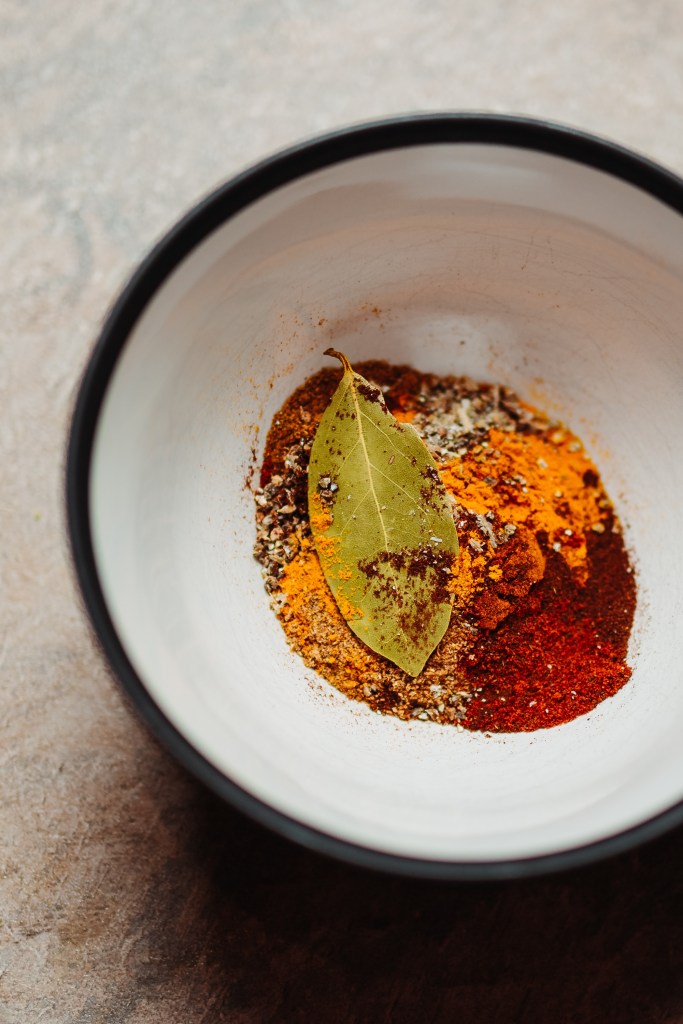
When I ask how they make it, the courtyard erupts in laughter. “With help,” says the one toasting on the open hearth. “How we feel,” answers another wrapped in an apron stained with color. “Patiently,” responds the one pounding the metate. “With imagination,” declares the cook whose face shines from the cauldron’s heat.

To understand Oaxaca is to immerse in its complexities of mole. Every family prepares its own, the exact methods handed down through matrilineal lines, often with a few ingredients changed or some steps hidden from the next generation. Thus the evolution of modern mole is wrapped up in myth, in Nahuatl history, and in the knowledge passed through female bodies. In its contemporary global form, the chocolate-like condiment known as mole negro has gained recognition among foodies for its bitter, silky quality. The original mōlli (Nahuatl for sauce) was a chili pepper concoction which has morphed into a multiplicity of varieties — coloradito, chichilo, mancha manteles, poblano — that continue to flavor the lives of Oaxacans.
Mole making is a ritual in the communities, a spiritual homage to nature’s gifts. It is an act of love labor that takes days. The resulting sauce is a celebration of life. The sauce makers in the courtyard kindly invite me to join the process. They are generous with instructions as I help clean peppers, peel tomato skins, stir the broth. They chuckle when the spicy fumes make me cough. “The evil is coming out of you,” the chili soaker prophecies, thumping my back. Unlike me, the mole architects move effortlessly around each other. Their minds and forms make space for one another’s steps, their hands link and separate to a music I cannot hear. There is no hierarchy here — each person is vital, each gives of their time, each has worth to bring to the mole.

When the community sits down for the feast, I notice a return to social stratums. The women cooked, the men eat. The conversation around the making of mole was centered on domesticity, ritual, making do. Now the talk expands, expounding on success, settling disputes. A few hands brewed with compassion. Now many hands reach for the fruit of that service, dipping steaming tortillas into the bubbling sauce, ladling it onto their chicken, sopping it up with their greasy fingers.
Trying to manage my plate of rice and vegetables lathered in mahogany hued mole, I think about how I’ve taught myself to perform eating in public. Shamed by elitist ideas of cleanliness and etiquette, I’ve surrendered tactile connection with food for the “superiority” of utensils. I’ve relinquished communal conversation for the “refinement” of chewing in silence. I’ve given up touching knees around the familial circle for an isolated “culture” of elbows hidden under tables. I ponder those learned practices now and about the ways they’ve cleaved me from enjoyment, satisfaction, participation. How can eating food together move beyond cursory gatherings where we conceal true hungers? How can ingredients stop being commodified and privileged by the few? How can those who only consume at the table also engage in the gift of cooking for others?

In Korean tradition it is believed that a person’s character is imparted into the food they cook. Tasting this Oaxaca mole, I can believe it. I savor the sacredness of the meal, the hopes of the many hands who toiled to perfect its layers, the desire to pass on lessons of the past for a better future.
BT’s MOLE COLORADITO RECIPE
Serves 6 persons Total Time: 1 hour 45 minutes [Prep Time = 15 min. Cook Time = 1 hour 30 minutes]
WHAT YOU NEED
6 whole dried ancho chilies
5 whole dried guajillo chilies
4 whole medium sized ripe tomatoes
4 garlic cloves, unpeeled
1 whole large white or gold onion
60 mL (¼ cup) vegetable oil
120 mL (½ cup) sesame seeds
4 1/5 grams (1 tsp) oregano
1/5 gram (⅛ tsp) ground cloves
1 2/5 grams (¼ tsp) ground pepper
6 2/5 grams (1 ½ tsp) ground cinnamon
30 grams (2 Tbsp) raisins
30 grams (¼ cup) slivered almonds
19 grams (3 Tbsp) bread crumbs*
2 Tablets Mexican chocolate, chopped (optional)
1 liter (4 cups) vegetable broth
salt to taste
WHAT TO DO
- Remove the ancho and guajillo chili stems, cut slits individually into each pepper and remove all the seeds. You are looking for the flavor of the chili not the heat.
- Toast the chili peppers in a heavy frying pan over low heat for 10 minutes or until both sides of the pepper begin to blister. The guajillo chilies have thicker skin and may take longer to char.
- Place the toasted chilies in a bowl. Cover with very hot water and let them soak for 20 minutes.
- Meanwhile, roast the onion, garlic cloves, and tomatoes in a skillet at medium-high heat for 8-10 minutes or until the skins of all these are completely charred. Make sure to turn the vegetables so that all sides get blackened. Remove and let cool, then peel the skins of the tomato, onion, and cloves. Slice the onion into thin pieces.
- In the same skillet at medium heat add 1 tablespoon of vegetable oil. Toast the sesame seeds for 2 minutes or until they brown, being careful not to burn them. Remove and, if needed, add another tablespoon of oil. Now toast the slivered almonds and raisins until the raisins are plump (around 3 minutes) and the almonds are light brown in color (should take about 4 minutes).
- Finally, adding more vegetable oil as needed, toast the bread crumbs* for 12 minutes in the skillet or until they are crisp.
- In a blender puree the chilies along with half the water they were soaked in, tomatoes, onion, garlic, sesame seeds, oregano, cloves, ground pepper, cinnamon, raisins, almonds, and salt to taste until the mixture is smooth.
- Heat 2 tablespoons of oil in a heavy pot over medium-high. Cook the chili sauce for 5 minutes or until thickened. Add in the vegetable broth and let cook for 20 minutes or until this mixture also thickens. Mix in the bread crumbs and the optional chopped chocolate. Set to simmer, stirring occasionally for another 20 minutes or until the sauce reduces to a silky thickness. Add salt to taste, if needed.
- Serve mole over enchiladas, over sautéed or roasted chicken, or with tortillas. Share and enjoy!
* BT Tip: If plantains are available to you, substitute 1 ripe plantain for the breadcrumbs. Make ½-inch slits in the plantain skin, place on an aluminum sheet and bake at 204℃ for 40 minutes or until completely cooked. When cool, peel and slice, then add to the blender. This will give a sweet, starchy thickness to the mole.
Discover more from Bespoke Traveler
Subscribe to get the latest posts to your email.





Beautiful post, and it made me long for good mole and for Oaxaca ~ and especially for the atmosphere during the meal. You’ve written a great line which highlights the beauty of meals in Mexico: “I’ve given up touching knees around the familial circle for an isolated “culture” of elbows hidden under tables…” Wonderful writing and photographs ~ what a great experience.
I so appreciate your attentive comment. I found during my stay in Oaxaca that I’d so much to learn about community when it came to cooking, eating, and sharing of resources. I hope this finds you well and enjoying your own communal meals. Thank you!
Mole is a very strong mexican tradition.
Hope all is well.
Happy New Year of the Tiger. 🐯
Happy new year of the tiger to you as well! 🐅
🙏🏻
I’ve never had mole but this makes me want to taste it! I love the way the making of it is a communal experience and that each family passes down their own recipe. You’ve described it in such a vivid way that I felt like I was part of making it.
Thank you so much. Hopefully you’ll enjoy the taste of mole once you try it! Wishing you well.
Hello Bespoke Traveler,
A bespoke meal sounds like what it was! And the photographs exactly right, bespoke too.
Thank you.
Rebecca Pyle
Thank you for such kind words and for stopping by to read the post. Wishing you well.
I once made mole with blueberries for the Bluesberry Festival cook-off in Lafayette, Louisiana. After many many hours, it came out beautifully. “Patience” for sure. Very cathartic. Your images are scrumptious! “In Korean tradition it is believed that a person’s character is imparted into the food they cook.” I love this.
Thank you for sharing your story and for your kind comment. Having made mole you understand what goes into it is so much more than the individual ingredients. Wishing you well.
I felt transported to the scene of the cooking and eating. As always your writing feels like being immersed in the experience.
Thank you Sue. It’s always a pleasure to have you stop by to read my posts. Hoping this finds you well and safe.
Ah, mole!! I confess that I cheat making mole, I just buy the paste premade, and doctor it to my taste, doing it from scratch, it’s just too demanding, and takes too long, but I describe a post about a thanksgiving meal on November 29, 2020, when I cooked mole for a Thanksgiving meal in Montecito CA, we were invited, over twenty five years ago, it was sort of funny, since my girlfriend thought nobody will eat it.
I have not cooked it in a while, I should do it again.
It’s amazing what things become popular in society. As you say, mole is time consuming, so I’m happy to hear the paste allows you to enjoy the sauce without as much effort. Wishing you well.
Once again you have concocted a delectable post. Between the engaging writing and the beautiful photos, you draw us in close. Your questions are important ones. Traveling is one way to appreciate new ways of doing the things we take for granted. I’ve wanted to go to Oaxaca for a long time – maybe I will get there one day. The only mole I’ve had was in Mexican restaurants stateside and I suspect it was nothing like what you describe. Thank you for transporting me to a lovely place for a few minutes – and the recipe looks terrific!
I appreciate your kind words. In Oaxaca, the cuisine was some of my favorite and I suspect a large part of this was due to how closely I was able to see the preparation and labor that went into many of the dishes while there. Wishing you a very wonderful New Year.
That’s a good point about seeing the preparation and what it adds to the experience. Best wishes to you for 2022, too. 🙂
Merci Bespoke Traveler pour ce beau billet et merci de votre gentil visite chez moi.
Je vous souhaite une très belle, douce et sereine nouvelle année avec toutes mes amitiés 🙂
Quite a lot goes into this recipe. I will have to have some next time we go to our favorite Mexican restaurant!
It is a very complex recipe and there are many variations to the mole sauce, not only within Oaxaca, but also from other regions of Mexico. I hope you enjoy your mole!
I’m bad at cooking myself but your delightful food photos make me feel going to the kitchen! In my family, my mom doesn’t have recipes that I could learn. She would always say, add this a little, add that a little more, or that is less than this. There is no measurement and to get it right, add everything ‘to taste’. Asian style, haha.
Wishing you a happy and wonderful new year 2022!
Haha, yes I know exactly what you mean! My mother cooks in the same way and as someone who is used to following steps and precise measurements it can get very frustrating to learn dishes from her! She’s always saying, “you’ll just know it when it’s right.”
Hope you have a wonderful New Year as well!
Your writing reminds me of why I love to cook.
Thank you for such a lovely praise. Hoping this finds you safe and well.
I’m not much into following recipes and never was. I tend to throw stuff together and hope for the best and it usually works out okay. However, this looks great. When can I come over for dinner??? Ha, ha. Cheers, Muriel
Haha, thank you! You are always welcome over anytime. Some wine and your jokes would be great additions to the mole. I wish I was talented enough to simply throw things together…or maybe it’s courage I’m lacking in the kitchen? But, I’d be happy to taste-test any of your cooking experiments. Take care, Muriel.
What a lovely read. I’ve never followed cooking blogs, I’m not a foodie, and I’ve tasted mole only once, in Guanahuato not Oaxaca, and I didn’t like it. But your description, your story-telling carried me along, into another world that I’d like to experience. If I ever get to travel again perhaps I’ll put an exploration of local food preparation closer to the top of the list of experiences. It sounds like so much fun, and reminds me of childhood when we all cooked together.
And this: “Unlike me, the mole architects move effortlessly around each other. Their minds and forms make space for one another’s steps, their hands link and separate to a music I cannot hear.” This reminded me so strongly of a time in my 20’s working with 2 or 3 others in a very busy bar – the way we would, with hands full with almost over-flowing drinks, dance around each other from one end of the bar to the other from prep areas to cash registers to customers with nary a spill nor a bump.
Happy New Year Atreyee. May 2022 be all you could wish for.
Alison
I so appreciate your comment Alison! What a delight to have moved someone in such a way with my post. While I don’t know whether I would term myself a foodie, I do believe in the incredible power of food to bring people together, evoke strong emotions, and change how we view our cultures. One of the delights of traveling has been to be able to participate in the preparation of dishes in stranger’s homes and see how their lives revolve around their kitchens.
Wishing you a most wonderful 2022 in your neck of the woods.
Sometimes I get paranoid that the food I’m making will taste bad if I don’t have my head in the right space. In other words, I try not to cook angry or agitated. Of course, sometimes it takes cooking to calm yourself down.
Your words remind me that it takes many hands to feed a village. Thanks, xo
I love that you think about your emotions before preparing food. What a wonderful way to make sure that the dishes you make don’t imbibe your negative feelings. I do believe food cooked with love and care tastes much better than that made simply because it has to be or done solely for profit.
Hoping this finds you safe and well. XO.